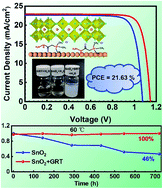Multifunctional organic ammonium salt-modified SnO2 nanoparticles toward efficient and stable planar perovskite solar cells†
Abstract
Bulk and interfacial nonradiative recombination hinder the further enhancement of the power conversion efficiency (PCE) and stability of SnO2-based planar perovskite solar cells (PSCs). To date, it is still a huge challenge to minimize the bulk and interfacial nonradiative recombination losses, and thus maximize the potentials of PCE and stability. Herein, a novel and effective multifunctional modification strategy through incorporating Girard's Reagent T (GRT) molecules with multiple functional groups to modify SnO2 nanoparticles (NPs), which significantly reduces the bulk and interfacial nonradiative recombination losses through the simultaneous achievement of suppressing nanoparticle agglomeration, improving the electronic property of SnO2 films, facilitating the vertical growth and enlarging the grain size of perovskite crystals, and passivating interfacial defects is reported. As a result, the device based on GRT modification delivers a much higher PCE of 21.63%, along with significantly suppressed hysteresis, as compared to the control device (19.77%). The device stability is ameliorated after GRT modification. The unencapsulated device with GRT maintains 99.5% of its initial PCE after aging at 60 °C for 720 h and 58.5% after illumination for 672 h under one sun, respectively. The present work provides guidance for the design of multifunctional modification molecules toward efficient and stable PSCs.



 Please wait while we load your content...
Please wait while we load your content...